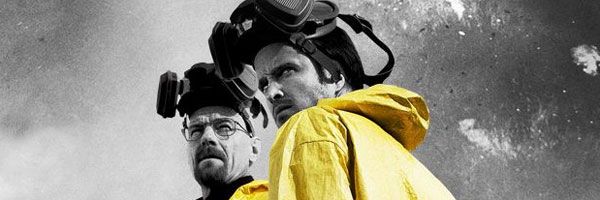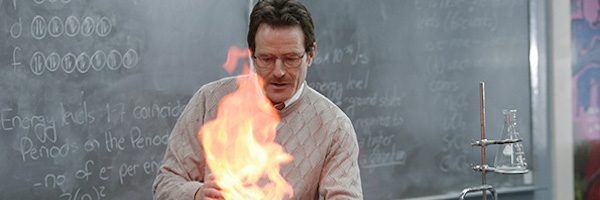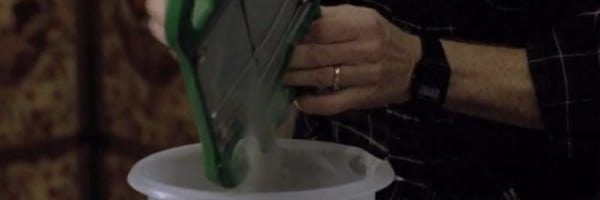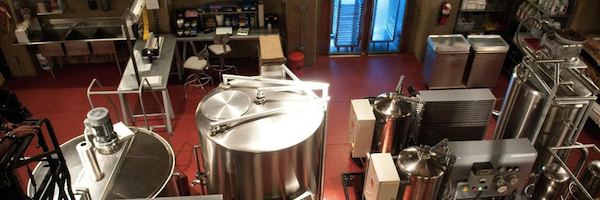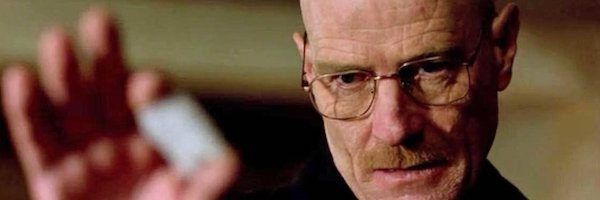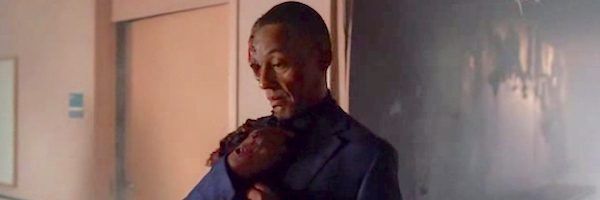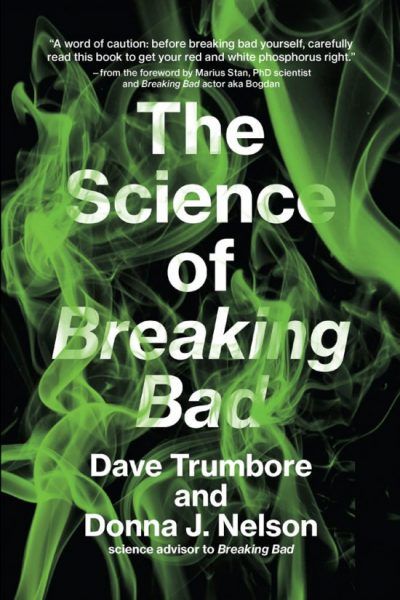I absolutely love the many ways that Breaking Bad embraced science. I love it so much, in fact, that I wrote a book about it--"The Science of Breaking Bad" from MIT Press--along with my co-author and Breaking Bad science advisor, Dr. Donna Nelson. It's crazy to think that a science-explainer article that I originally wrote way back in 2013 during the show's fifth and final season is now a published tome that includes insider insight, in-depth research and explanations, and lots of fun trivia about how Breaking Bad pulled off all those stunning yet scientifically accurate sequences with the help of Hollywood's special effects.
Walter White Has Fun with Fire
“Electrons, they change their energy levels. Molecules change their bonds. Elements, they combine and change into compounds. That’s all of life, right? It’s the constant, it’s the cycle. It’s solution, dissolution. Just over and over and over. It is growth, then decay, then transformation. It is fascinating really.” – Walter White, Season 1, Episode 1, “Pilot”
[From Chapter III. "Playing with Fire"]
While waxing poetic about the nature of chemistry, Walt delivers a high school classroom chemistry lesson early on in the series. He lights a Bunsen burner and casually sprays different solutions into the flame, turning it alternately red and green for a short period of time. Sure, it's not exactly "explosive" either visually or by definition, but this lesson foreshadows an explosive moment to come while also laying down a scientific foundation for basic chemistry and for Walt's eventual transformation into Heisenberg. But what's going on with the light show here?
Like Walt says, electrons and atoms in matter aren’t just sitting still, they’re shifting, changing, combining and breaking apart again in a never-ending cycle. But at the same time, energy can neither be created nor destroyed, according to the first law of thermodynamics, also known as the Law of Conservation of Energy. It can, however, change forms or transfer from one place to another.
One of the simplest demonstrations of this atomic activity is the introduction of a solution of metal salts (usually dissolved or suspended in alcohol) to flame. The heat from the fire temporarily excites the electrons in the solution, but when the heat is removed, the excited electrons fall back to their own normal resting state once again. Since energy can neither be created nor destroyed, the extra oomph has to go somewhere. In this case, it escapes in the form of a light-emitting photon of varying wavelengths. Presto change-o, you’ve got colored fire!
Heisenberg's Ultimate Lockpick
“In World War II, the Germans had an artillery piece - it's the biggest in the world - called the Gustav Gun, and it weighed a thousand tons. And the Gustav was capable of firing a seven-ton shell and hitting a target, accurately, twenty-three miles away. I mean, you could drop bombs on it every day for a month without ever disabling it. But, drop a commando - one man - with just a bag of this, and he could melt right through four inches of solid steel and destroy that gun forever.” – Walter White, Season 1, Episode 7, “A No-Rough-Stuff-Type Deal”
[From Chapter IX. "Pyrotechnics: Thermite Lockpick"]
When Walt and Jesse find themselves short on methylamine in the Season 1 finale, they are faced with two options: Pay $10,000 to professional thieves who will steal the precursor chemical from a guarded, secure warehouse, or steal it themselves. However, one big thing standing in their way—besides the obvious hazards of subduing guards and avoiding being identified by security cameras—is the heavy-duty lock on the steel door barring the entrance to the supply room. Luckily, Walt gets a bolt of inspiration from a simple children’s toy: the Etch-a-Sketch Sketcher-roo!
You may never have wondered just how a Sketcher-roo makes the pictures that it does, but this is as good a place to learn that factoid as any. Inside the Sketcher-roo is a metallic powder which coats the inside surface of the glass display. It’s this powder that is scraped away, using the knobs that control a stylus, in order to make a drawing. (There are also small plastic beads mixed in to keep the powder flowing freely, which is what accounts for the familiar sound you get when you turn the toy upside down and shake it to erase the drawing, depositing powder back onto the glass.) Walt knows that this particular powder is one of two components--the other being a metal oxide (like the iron oxide, rust)--in a very potent mixture called thermite. By simply placing the bag of homemade thermite on top of the facility door’s substantial lock and setting it on fire with a blowtorch, Walt and Jesse are able to break into the chemical supply storage with relative ease.
Walt’s lock-picking chemistry knowledge is a surefire recipe for success here. Thermite, when ignited, goes through a very energetic chemical reaction that gives off enough heat to melt or cut through metal, making it a go-to option for on-site welding; it’s also been used in military applications to disable equipment and weaponry. This surprisingly simple compound, which even burns underwater, could certainly melt away a steel lock, so this one is scientifically sound.
So Long, Superlab
“We're not going to need pseudoephedrine. We're going to make phenylacetone in a tube furnace, then we're going to use reductive amination to yield methamphetamine. Four pounds.” – Walter White, Season 1, Episode 7, “A No-Rough-Stuff-Type Deal”
[From Chapter XVIII "The Lab Maketh the Meth"]
Fans appreciated that Walt and Jesse (eventually) got to move up in the world of meth-making by taking up residence in Gus Fring’s clandestine facility dubbed the Superlab. This was a gorgeous setting despite all the ugliness that would take place there. Vince Gilligan’s original thematic idea for the Superlab was that it should feel like a bunker. It fell to production designer Mark Freeborn to design the lab, while the actual building of the two-story, practical set was carried out by construction coordinator William “W” Gilpen and their crews.
Built to look like it’s made out of board-form concrete, the set actually used a thin veneer of plaster to mimic the bunker-like aesthetic. Parts of the walls themselves could be removed to accommodate cameras and/or crane placement. The steel staircase and catwalk were built to code and the lab itself was outfitted so that you could literally cook meth on the set, per Gilligan. Not that they ever did, of course.
From a writing standpoint, it’s the next step in the clever evolution of the show’s meth-making facilities that allow Walt and Jesse to carry out their cooks while also offering protection from discovery. The cover story in this case is provided by the industrial laundry, which receives regular chemical deliveries and vents “clean, odorless steam” thanks to an over-engineered filtration system. Ingenious. Though this fantastic set was eventually dismantled, the production team had to build a duplicate in order to show the Superlab in its destroyed state when it’s being combed over by the DEA in the Season 5 premiere, “Live Free or Die.”
Unfortunately, this season also saw the end of the Superlab. After Gus Fring’s explosive death, Walt and Jesse flooded the lab with methylamine and other solvents and rigged an electrical arc to a timer. This gave the meth-making MacGyvers enough time to flee the laundry facility—and pull the fire alarm—before a raging chemical fire cooked the Superlab for good. It was a beautiful set and the site of quite a bit of fictionalized real-world science. It will be missed.
Crazy Handful of Nothin'
“The faster reactants, i.e. explosives—and fulminate of mercury is a prime example of that—the faster they undergo change … the more violent the explosion.” – Walter White, Season 1, Episode 6, “Crazy Handful of Nothin’”
[From Chapter VIII "Explosives: Fulminated Mercury and the Wheelchair Bomb]
Some of Breaking Bad’s most memorable moments are literally the show’s most explosive. On two separate occasions, Walt uses his knowledge of chemistry to create explosive compounds in order to gain leverage: One is used as a bargaining chip with small-time drug lord Tuco Salamanca, and the other is used to dispatch the intimidating drug emperor Gus Fring. But to fully appreciate the powerful potential of explosives, we need to understand their chemistry.
Explosives have been around a long time, since at least the Chinese invention of black powder used for mining and military purposes in the 9th century. An explosive can be defined as a reactive substance that contains a great amount of potential energy that can be released suddenly in an impressive display of light, heat, sound, and pressure, otherwise known as an explosion. These explosives have less potential energy than fuels, but the release of this energy happens at a much faster rate. In chemical explosives, this energy is stored as chemical energy in the bonds between atoms.
As Walt mentions to his class in Season 1, Episode 6, “Crazy Handful of Nothin’”, chemical reactions involve change on two levels: matter and energy. A gradual reaction can proceed slowly or result in a barely noticeable change in energy, while an explosive reaction has quite the opposite result. In chemistry terms, in an explosive reaction the change from reactants to the more stable products is accompanied by a great release of heat, gas, and much sound and fury. And when a chemical explosive is as highly sensitive as fulminated mercury (due to its sensitivity, the compound is stored under water to prevent self-detonation until it’s ready to be used) it doesn’t take much to trigger the explosive reaction and release all that stored-up energy.
In this same episode, Walt also delivers some excellent foreshadowing disguised as a classroom lesson on explosive chemicals, like the aforementioned fulminated mercury. This exotic-sounding material is an example of a primary explosive, a chemical compound that can be detonated without much external stimulation through impact, heat, or electricity, to name a few. Later in the episode, Walt actually has this particular explosive chemical compound on hand in order to keep drug dealer Tuco Salamanca and his goons at bay. Walt uses a relatively small amount (50g) to make his point, detonating it by throwing it on the ground like an amped-up bang snap which results in a concussive blast that blows out the windows of Tuco’s headquarters.
But while fulminated mercury is a very sensitive primary explosive, Breaking Bad’s depiction of it does not line up with the compound’s real-world appearance, potency, or sensitivity. Adding insult to literal injury, a blast of the size seen in the episode would definitely have injured everyone in the room and exposed them to toxic mercury dust to boot. Sorry, Heisenberg. (A MythBusters special did a fantastic job of breaking this scene down if you’re interested in seeing how it all plays out after learning the science behind the scenes.)
Gus Fring's Final Face-off
“Jesus, Walt, the news here. Gus Fring is dead. He was blown up along with some person from some Mexican cartel, and the DEA has no idea what to make of it. Do you know about this? Walt? I need you to–"
"It’s over. We’re safe."
"Was this you? What happened?"
"I won." - Skyler and Walter White, Season 4, Episode 13 “Face-Off”
[From Chapter VIII "Explosives: Fulminated Mercury and the Wheelchair Bomb]
In one of the most shocking moments from the entire run of Breaking Bad, Walt takes out two of his antagonists in one fell swoop by pitting their mutual animosity against each other. This time, Walt isn’t aiming for intimidation or distraction but rather outright death and destruction.
In Season 4, Episode 12, “End Times”, Walt can be seen harvesting cold packs for their potentially explosive chemicals and combining them with common vegetable oil, which apparently results in a bubbly, charcoal-colored sludge when boiled. We next see a metal canister laid out on the kitchen table while Walt tinkers with a battery-powered circuit board that produces a spark when he presses a button a walkie-talkie. What’s all this mad science about? A homemade pipe bomb, of course. Walt’s small-scale test in the kitchen is enough to trigger a tiny amount of detonating compound, but the big boom comes in the Season 4 finale, “Face-Off.”
Essentially, Walt makes a DIY ANFO bomb. ANFO is a precisely mixed combination of compounds that makes for a cheap and reliable explosive widely used in a variety of industries, though the chemistry is sometimes co-opted for malicious purposes which is not the purpose of this book. Putting that explosive inside a metal canister to turn it into a pipe bomb and then strapping it to an old man’s wheelchair in a nursing home is about as malicious as it gets. (The writers were careful to note in the radio news report following the blast that “only” three people were reportedly killed--Tyrus, Gus, and Hector Salamanca—avoiding any collateral damage.)
We can presume that master-chemist Walter White would have no problem making a batch of fulminated mercury or figuring out the chemical composition and mixture of an ANFO bomb, but it took some serious supervillainy to pull off the explosive assassination. We'll tip our hats to Heisenberg (and the behind-the-scenes teams) for delivering one of the most memorable moments ever in Breaking Bad.

